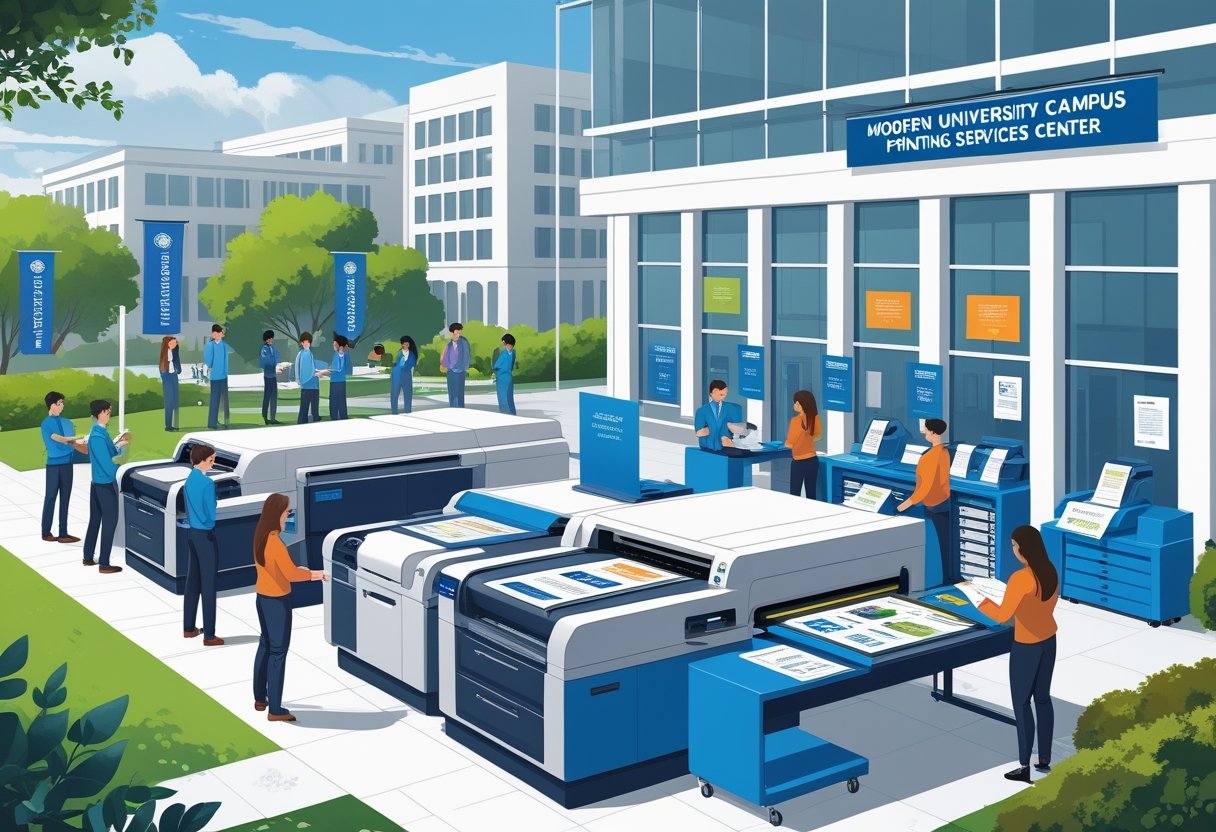Choosing eco-friendly printing paper is a crucial step in reducing your environmental footprint while maintaining quality in your projects. To make an informed decision, look for paper that is certified by the Forest Stewardship Council (FSC) or made from recycled materials. These certifications ensure that the paper is sourced responsibly and minimizes negative impact on forests.
When you select sustainable paper, consider the type of ink used as well. Water-based and vegetable-based inks are great options that contribute to a more eco-friendly printing process. At Mail Processing Associates, we understand the importance of these choices and offer a variety of comprehensive mailing and printing solutions tailored to meet your business needs.
Your commitment to sustainability can make a significant difference. By choosing the right type of eco-friendly paper, you not only enhance your brand's image but also promote environmental stewardship, making a positive impact in the process.
Understanding Eco-Friendly Printing Paper
Choosing eco-friendly printing paper is an essential step in reducing your environmental impact. The right paper can significantly lower your carbon footprint and promote sustainable practices in your business operations.
What Is Eco-Friendly Paper
Eco-friendly paper is produced from sustainable resources, such as recycled fibers, bamboo, or hemp. It often lacks harmful chemicals that can pollute the environment during production. Look for papers that are certified by organizations that promote responsible forest management such as the Forest Stewardship Council (FSC).
By choosing these options, you not only support sustainable harvesting practices but also contribute to the reduction of waste. Many eco-friendly papers are designed to offer the same quality and performance as conventional paper, providing a smart alternative for your printing needs.
Why Sustainability Matters in Printing
Sustainability in printing is critical for various reasons. It helps protect forests, reduces greenhouse gas emissions, and conserves water. The printing industry is a significant contributor to carbon footprints, primarily through energy-intensive processes and the use of non-sustainable paper.
Incorporating eco-friendly practices can enhance your company's reputation and appeal to environmentally conscious consumers. As more companies strive to improve their sustainability practices, aligning your printing choices with these values demonstrates a commitment to a healthier planet.
Key Benefits of Eco-Friendly Paper
Using eco-friendly paper carries numerous benefits that extend beyond environmental considerations.
- Reduced Environmental Impact: Using recycled or sustainably sourced paper minimizes deforestation and conserves natural resources.
- Cost Efficiency: While prices can vary, many eco-friendly options can lead to long-term savings through improved efficiency and reduced waste.
- Enhanced Brand Image: Choosing sustainable printing materials can improve your brand's reputation, attracting customers who prioritize corporate responsibility.
- Quality Without Compromise: Many eco-friendly papers perform exceptionally well, ensuring high-quality prints without sacrificing standards.
Mail Processing Associates provides comprehensive mailing and printing solutions tailored to your business needs. By choosing our services, you embrace eco-friendly practices while optimizing your processes effectively.
Types of Eco-Friendly Paper
When selecting eco-friendly printing paper, understanding the different types available is crucial. Each category offers unique benefits that can align with your sustainability goals and printing needs.
Recycled Paper Options
Recycled paper is produced from waste paper materials rather than virgin pulp. This option significantly reduces the need for new trees, preserving forests and minimizing resource consumption. Recycled paper can be used for various applications, from business documents to marketing materials.
You will find that recycled paper maintains quality similar to traditional options. Additionally, it is available in several finishes and weights, providing versatility for your projects. Look for papers with high post-consumer content for the best environmental impact.
Post-Consumer Waste Paper
Post-consumer waste paper refers specifically to paper that has been recycled from products consumed by the public, such as newspapers and office paper. Using post-consumer waste helps divert waste from landfills and reduces the energy required to produce new paper.
This type of paper is certified by various standards that ensure environmental responsibility. Many organizations, including the Forest Stewardship Council (FSC), provide certifications that verify the sustainability of these products. By choosing post-consumer waste paper, you demonstrate a commitment to responsible sourcing.
FSC-Certified Paper
FSC-certified paper comes from forests that are managed in an environmentally sustainable and socially responsible manner. The Forest Stewardship Council ensures that these practices protect biodiversity and the rights of local communities.
When you choose FSC-certified paper, you support responsible forestry practices that benefit the planet and its inhabitants. This paper option can be used in a variety of applications while maintaining high-quality standards. It is an excellent choice if you want to uphold sustainability while ensuring optimal results for your printing needs.
Tree-Free and Agricultural Waste Paper
Tree-free paper is made from alternative materials, such as hemp, agricultural byproducts, and other fast-growing plants. This option provides a sustainable solution to traditional paper production, significantly reducing deforestation.
Using materials like bamboo or sugarcane not only lessens the environmental impact but also offers unique textures and characteristics. These papers can serve diverse printing needs, from art prints to packaging. Choosing tree-free and agricultural waste paper represents a forward-thinking approach to sustainable practices.
Mail Processing Associates offers comprehensive mailing and printing solutions that incorporate these eco-friendly paper types. Our services are tailored to meet the needs of any business looking to optimize their mailing and printing processes.
Evaluating Printing Paper for Environmental Impact
When choosing printing paper, it’s crucial to consider its environmental impact. Focusing on the recycling process, carbon footprint, and certifications helps you make informed decisions that align with sustainable practices.
Role of Recycling Process
The recycling process significantly affects the environmental impact of printing paper. Papers that contain recycled content help reduce the amount of waste in landfills. Additionally, recycling paper can save energy and water compared to producing new paper from virgin fibers.
Look for papers with a high percentage of post-consumer recycled content. This indicates that the paper has been used and processed before, minimizing the need for new resources. Recycled paper generally requires less energy to produce, resulting in a lower carbon footprint.
When selecting, verify the recycling capabilities of your local facilities. Not all types of paper can be recycled, so choosing one that can be easily processed helps enhance the sustainability of your efforts.
Assessing Carbon Footprint
Understanding the carbon footprint associated with paper production is essential for making eco-friendly choices. The carbon footprint comprises the total greenhouse gas emissions throughout the paper's lifecycle, from raw material extraction to manufacturing and distribution.
Opt for papers produced with less energy-intensive methods. For example, FSC-certified paper often uses sustainable practices that reduce overall emissions. By choosing paper with a smaller carbon footprint, you significantly contribute to minimizing environmental harm.
Additionally, consider your transportation methods. The distance your paper travels to reach you can affect its total carbon footprint. Locally sourced papers or those with reduced transportation impacts can be better options.
Understanding Certifications and Labels
Certifications and labels are powerful indicators of a paper's environmental credentials. The Forest Stewardship Council (FSC) certification is a prominent example that assures you the paper comes from responsibly managed forests.
Look for labels indicating recycled content, such as the Recycling Mark. These labels clarify how much recycled material is in the product and help guide your choices. Papers that are both FSC-certified and contain recycled content represent some of the most sustainable options available.
When choosing paper for your printing needs, consider Mail Processing Associates for Comprehensive Mailing and Printing Solutions. Our knowledgeable team can help you select the best environmentally friendly options tailored to your business’s requirements.
Selecting the Right Paper for Different Printing Needs
Understanding the specific requirements for your printing project is crucial. The choice between paper types can significantly impact both functionality and environmental sustainability. Knowing how each type serves different purposes will help you make informed decisions.
Uncoated vs. Coated Papers
Uncoated paper is absorbent and offers a natural finish. It works well for everyday documents such as letterheads and reports, providing good readability. This type of paper is often preferred for eco-friendly printing because it usually contains fewer chemicals.
On the other hand, coated paper has a smooth finish that enhances color depth and sharpness. It's ideal for high-quality marketing materials like brochures and posters. The coating, while providing visual benefits, can sometimes limit recyclability depending on the materials used. Choose uncoated for internal use and coated for external marketing to balance aesthetics and eco-friendliness.
Choosing Office Paper
When selecting office paper, consider both the purpose and the printer type. For general use, aim for recycled paper options that have similar performance as standard paper. This choice supports sustainable practices while ensuring a professional appearance.
If you're printing documents requiring high-quality graphics, consider a heavier weight paper that supports vibrant prints. Look for options with certifications that indicate sustainable sourcing, such as Forest Stewardship Council (FSC) certification. At Mail Processing Associates, we offer a range of eco-friendly papers that cater to both quality and environmental considerations, meeting the diverse needs of your business.
Sustainable Marketing Materials
For marketing materials, your paper choice can affect both branding and sustainability. Opt for papers with recycled content to communicate your commitment to the environment.
Different marketing materials, such as flyers and business cards, can utilize various paper weights and types. Lightweight, uncoated paper works well for brochures, while coated stock is preferable for invitations or high-impact promotional items.
Consider options like biodegradable laminates for added durability without compromising on environmental responsibility. Partner with Mail Processing Associates for comprehensive solutions tailored to your marketing needs, ensuring you achieve appealing results while maintaining eco-conscious practices.
Best Practices for Eco-Friendly Printing
Adopting eco-friendly practices in printing is essential for minimizing environmental impact. Focus on optimizing digital printing, reducing waste, and partnering with sustainable printers for effective solutions.
Optimizing Digital Printing Methods
Digital printing offers several advantages for eco-friendly practices. It minimizes waste since it allows for short runs, eliminating the need for large overproduction. Using high-quality, eco-friendly inks is vital. Consider inks made from vegetable oils or natural pigments, which reduce hazardous waste.
You can also select printers that utilize energy-efficient equipment. Look for machines certified for energy efficiency to lower electricity consumption. Always optimize your print settings, such as duplex printing, to save paper. By using recycled paper, you further enhance sustainability while maintaining quality in your projects.
Reducing Waste and Overprinting
To reduce waste, you should evaluate your printing needs carefully. Implement a print policy that encourages digital documents where possible. You can also set limits on color printing for documents that do not require it.
Establish guidelines for using office paper efficiently. Be mindful of margins and font sizes to maximize space on each page. Use proofs and samples judiciously, ensuring designs are final before printing in bulk.
Finally, consider adopting a print-on-demand model. This method further minimizes excess printing and aligns with sustainable practices. By implementing these strategies, you significantly reduce your carbon footprint and operational costs.
Partnership with Sustainable Printers
Choosing the right printing partner is crucial for maintaining eco-friendly practices. Look for printers like Mail Processing Associates, which prioritize sustainability in their processes. Verify certifications such as FSC (Forest Stewardship Council) or SFI (Sustainable Forestry Initiative) to ensure responsible sourcing.
Collaborating with sustainable printers can provide access to eco-friendly materials, such as recycled paper and biodegradable inks. You gain the expertise needed to enhance your brand’s commitment to environmental responsibility.
Mail Processing Associates offers comprehensive mailing and printing solutions tailored to your business needs. Partnering with us ensures that you utilize the best practices for eco-friendly printing while enhancing your brand reputation.
Frequently Asked Questions
When selecting eco-friendly printing paper, there are several important factors you should consider. These include sustainability criteria, relevant certifications, and how recycled content influences the environmental impact. Here are some common questions regarding eco-friendly printer paper.
What criteria define printer paper as sustainable or eco-friendly?
Eco-friendly printer paper is characterized by its sourcing and production processes. It should come from sustainable forests or use recycled materials. Additionally, the manufacturing process should minimize water usage and harmful chemicals to reduce its overall environmental impact.
Which certifications should I look for when selecting eco-friendly printing paper?
Look for certifications such as FSC (Forest Stewardship Council) or SFI (Sustainable Forestry Initiative). These indicators ensure that the paper comes from responsibly managed forests. Other labels, such as recycled content certifications, also highlight the paper’s eco-friendliness.
How does recycled content contribute to the eco-friendliness of printer paper?
Recycled content reduces the need for virgin materials, which helps conserve natural resources. It also lessens the energy and water required in production. The use of recycled content therefore plays a crucial role in making printer paper more sustainable.
Can you recommend eco-friendly paper brands for sustainable printing?
While you should explore various options, brands with FSC certification and those that offer substantial recycled content are generally reliable. You might also consider looking into specialty brands that focus exclusively on sustainable practices.
What are the environmental benefits of using eco-friendly printer paper?
Using eco-friendly printer paper saves trees, reduces waste, and minimizes the carbon footprint associated with paper production. These papers are often made using less energy and water, which makes them a better choice for the planet.
In what ways can the printing industry reduce its carbon footprint with paper choices?
The printing industry can adopt several strategies, such as choosing papers with high recycled content or using alternative materials like bamboo. By prioritizing sustainable options, companies can significantly lower their greenhouse gas emissions and promote environmentally friendly practices.
For comprehensive mailing and printing solutions tailored to your business, consider Mail Processing Associates. We streamline the mailing and printing processes to help you achieve sustainability goals while ensuring high-quality results.






.png)






